Benefits of the Tomatis® Method
When the ear-brain connection is not working perfectly (i.e., disrupted listening), the auditory system which is the most influential sensory integrator, is thrown off balance. This can have severe consequences for your or your child’s development, growth, and future well-being. The Tomatis® Method uses sound to rewire the brain, leading to improved motor skills, cognition, communication, and emotions. Explore the mechanisms that underlie the Tomatis® Method benefits.

Arouse Attention
Surprising the Brain
Have you ever tried to grab someone’s attention by snapping your fingers? The surprise element helps to get their attention. The brain is highly receptive to sudden changes that it wasn’t anticipating.
Likewise, the Tomatis® Method uses a proprietary patented technique called Electronic Gating® to capture the brain’s attention and improve attention skills. The method is designed to constantly surprise the brain through unpredictable changes in sound, which keeps the brain alert and attentive.
By developing the brain’s ability to detect changes, the method aims to reinforce selective attention and improve the individual’s capacity to divide their attention between multiple sources of stimulation.
Regulates emotions & Energises the brain
Adjusting the Brain’s Energy Level
The Tomatis® Method recognizes the ear as a vital audio-motor system that fuels the brain’s functions. It employs auditory stimulation to activate the ear, facilitating “cortical energizing.” Such activation can contribute to enhancing cognitive abilities including perception, consciousness, memory, and attention. The method incorporates high-frequency sounds, like Mozart’s compositions, for energizing purposes, and low-frequency sounds for relaxation.
Beyond coping or avoidance, the Tomatis® Method goes a step further by retraining the brain’s response to stimuli, aiming to eliminate the automatic fight-flight-freeze response. It helps re-educate the brain to interpret everyday experiences in a new way, thereby positively influencing stress, anxiety, and depression levels. Through either stimulating or calming the brain, the method cultivates a positive and adaptable response to one’s environment, altering how daily experiences are perceived and processed.
The Tomatis® Method harnesses the power of sound to recharge the brain, enhance well-being, and reshape the brain’s response to the environment, resulting in reduced stress and improved coping abilities.


Unlocking language potential
Stimulating the Auditory Feedback Loop
In moments of overwhelming emotions, have you ever noticed a shift in your voice tone? This is because the auditory feedback loop, responsible for analyzing the sounds of your voice, gets interrupted. The auditory circuit/loop connects auditory input and voice output allowing us to accurately perceive and produce speech. Disruptions in this loop can lead to difficulties in speech precision and learning.
The auditory feedback loop is the way sound travels from the ear to the brain and back to the ear, constantly. By modifying how the ear processes sound, the Tomatis® Method improves the auditory feedback loop. Through techniques like „Electronic Gating,“ high-frequency sounds in the listener’s voice are adjusted to challenge the brain and enhance language skills. The Tomatis® Method benefits manifest in improved speech, pronunciation, auditory discrimination, and rhythm integration.
Investing in the development of your or your child’s auditory feedback loop is crucial for improving speech and language abilities, becoming a more effective communicator, and enhancing overall learning skills. The Tomatis® Method offers a pathway to unlock these improvements and unleash the full potential of your voice.
Activate Motor Skills & Balance
Maximizing the vestibular system’s capabilities
When you walk, the vestibule plays a key role in maintaining balance, rhythm, and coordination. Try covering your ears when you walk, it will negatively affect your balance. Balance is determined by the vestibule, a part of the inner ear that informs the brain when the body moves.
The vestibule plays a crucial role in informing the brain of body movements and maintaining balance. The Tomatis® Method helps improve posture and balance by impacting the vestibule. It also allows the body to regain verticality by repositioning the skeleton. Repeated Tomatis® listening sessions lead to the synchronization of messages to the brain from both the right and left ears. This results in more fluid and organized motor responses, making it useful for individuals with motor disorders. The vestibule is also connected to the brain in a complex manner, making it vital in integrating the rhythms of language and music.


Cases where the Tomatis® Method is beneficial
The Tomatis® Method focuses on enhancing the three primary functions of the ear which include listening, balance, and coordination, and adjusting the brain’s level of energy through targeted auditory exercises and neuro-auditory stimulation. This is why it can be used in a variety of different fields. It makes it possible to multiply the results obtained and can significantly shorten the duration of a traditional therapeutic or medical plan.
By improving motor, cognitive, and emotional abilities, the Tomatis® Method can be applied to individuals of any age group, including children, adults, and seniors, and it can help address various difficulties and disorders of development like APD, SPD, ADD/ADHD, ASD, Speech and Language Disorders, Learning Difficulties, Emotional Regulation among many others.

The Tomatis® Method Benefits Proven with Research
The Tomatis® Method has been validated by more than 80 research papers, as well as by clinical and scientific studies. It continues to surprise and motivate researchers to do more. Complementary studies in the areas of music therapy, sound therapy, and neuroscience have supported the effectiveness and underlying principles of the Tomatis® Method. Here is an excerpt of some of the clinical and scientific studies conducted on a variety of disorders conditions:
-
Study of 41 Children with Auditory Processing Disorders (ADP) -90h of Tomatis sessions (no other support)
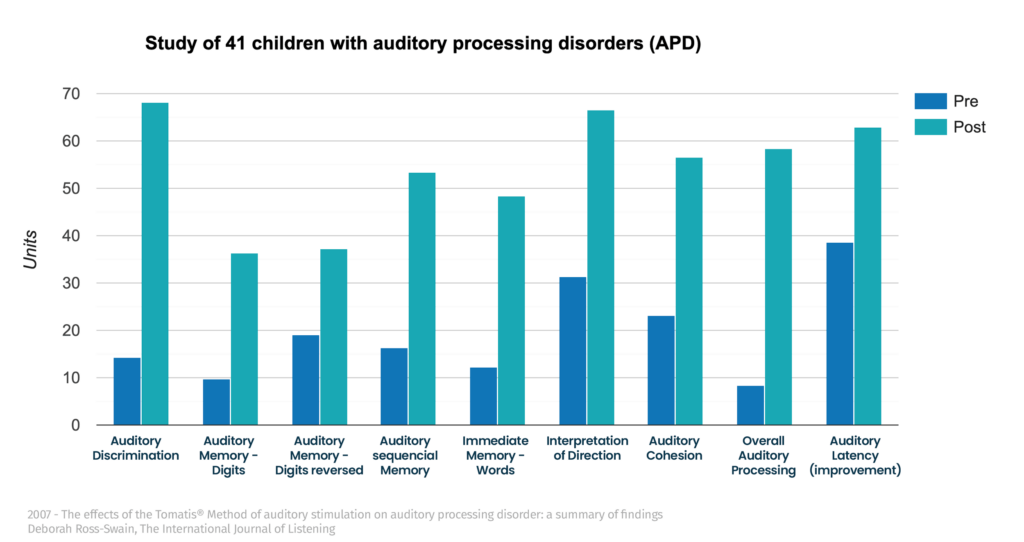
This retrospective study assessed the effectiveness of the Tomatis® Method, an auditory stimulation therapy, in managing Auditory Processing Disorders (APD) in 41 children and teens. After 90 hours of listening, significant improvements were noted in auditory memory, sequencing, interpretation, discrimination, and cohesion, with decreased auditory latency, suggesting its potential as an effective intervention for APD.
-
Areas of change for 100 Autistic Children
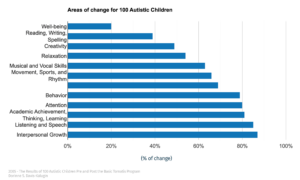
A study on 100 autistic children aged 3-21 showed significant improvements after 60 hours of Tomatis® Method listening therapy. 87% made change in Interpersonal Growth, 85% in Listening and Speech, 81% in Academic Achievement, Thinking, Learning, 80% in Attention, 79% in Behavior, 69% in Intrapersonal Growth to Know and Express Self, 66% in Movement, Sports, and Rhythm, 63% in Musical and Vocal Skills, 54% in Relaxation, 49% in Creativity, 39% in Reading, Writing, Spelling, and 20% in Well-Being.
-
Study of 100 adults with Stress Disorder - 90h of Tomatis sessions
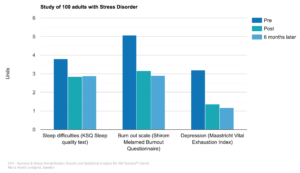
The study on the effectiveness of the Tomatis® Listening Program involved 100 adults diagnosed with Stress Disorder. It used three metrics to assess outcomes: the KSQ Sleep Quality Test for sleep difficulties, the Shirom Melamed Burnout Questionnaire for burnout levels, and the Maastricht Vital Exhaustion Index for depression. These measures were taken pre-treatment, post-treatment, and again six months later, offering a comprehensive view of the program's impact on these critical aspects of mental health.
-
Study of 29 Anxious Primary School Students
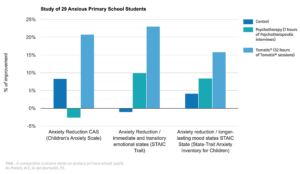
In the 1988 study by du Plessis and van Jaarsveld, 29 anxious primary students were evaluated for anxiety reduction through three methods: control, psychotherapy (7 hours), and Tomatis® program (52 hours). The Tomatis® approach showed the most improvement in anxiety levels across three metrics: CAS, STAIC Trait, and STAIC State.
-
Study of 25 Children with Attention Deficit (ADD) - 30h of Tomatis sessions
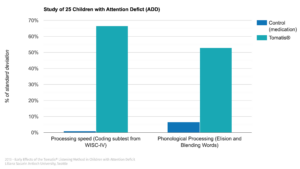
In a 2013 study by Liliana Sacarin of Antioch University, Seattle, 25 children with ADD underwent either medication or the Tomatis® Listening Method. Results showed significant improvements in the Tomatis® group, with 67% in Processing Speed and 53% in Phonological Processing, outperforming the medication group's 1% and 7% improvements, respectively.
-
22 children with Learning and Communication Difficulties
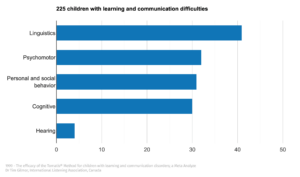
Gilmor’s meta-analysis is based on a study of 225 children with learning and communication difficulties. This analysis shows that the Tomatis® listening sessions have a significant impact in the following areas: language, cognitive and psychomotor development, and social and personal behavior.
-
Study of 1330 Children (with/without difficulties) in 63 Schools - European Union Study

A study led by the Institute of Physiology and Pathology of Hearing in Warsaw, funded by the EU, involved 1330 Polish pupils. It found that the Tomatis® Method improved learning, socialization, language, and musical skills in children, both with and without learning difficulties, suggesting its potential in school curriculums.
-
Study of 25 Learning Disabled Children
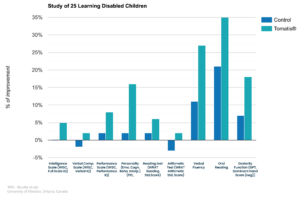
The 1992 Rourke study at the University of Windsor, Ontario, evaluated the Tomatis® Method on 25 learning-disabled children. It showed significant improvements in intelligence, verbal skills, reading, and dexterity, with gains up to 35% in oral reading. In contrast, the control group exhibited minimal or negative growth in these areas.
Start your journey with Tomatis®
To maximize your chances of success with the Tomatis® Method, please follow these steps :
Get your personalized Tomatis® Welcome Booklet
Find the best Practitioner with our interactive Map
Start your Listening Program and transform your Life




